13 Different Types of Purple Birds – A Comprehensive Guide
Updated: 25 Feb 2024
52
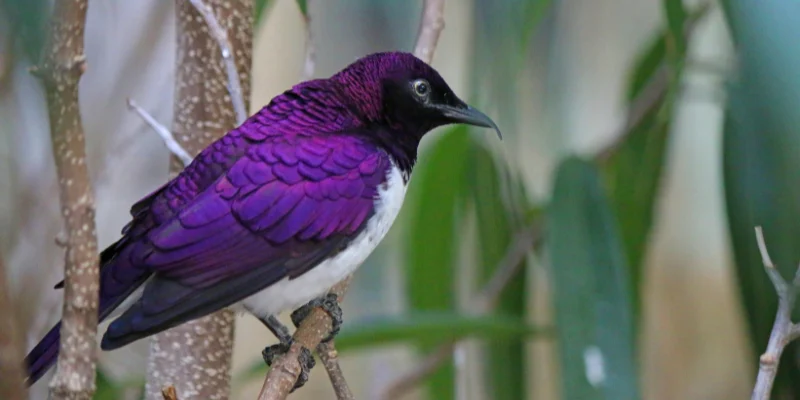
Birds come in a rainbow of colors, and purple is one of them. Similar to blue, the purple hue in bird feathers comes from structural features rather than pigments. This means that the shade of purple you see depends a lot on the lighting.
In specific lighting, some bird species can look purple, while in different conditions, they might appear blue or black. It’s fascinating how their colors can change!
But here’s an interesting fact: purple is not a very common color in birds. Out of all the colors, purple is the rarest. So, if you spot a bird with a beautiful purple hue, consider yourself lucky—you’ve seen something quite special!
In this article, we discover 13 stunning purple birds, learn how to identify them and find out where they call home.
Here is a list of the 13 most common purple birds in the world:
1. Purple Grenadier:

Purple Grenadiers have a unique look; all of them have black tails, and the grown-ups have red beaks.
The male has a cinnamon-colored head and neck, a cool blue eye band, and a purplish-blue back. The lower part of their bodies is a violet-blue color with some patches of reddish-brown.
The female, on the other hand, is mostly cinnamon brown, with white bars on their belly and silver-blue patches around their eyes.
They are also smaller in size. The young ones look like the ladies, but they have a reddish-brown beak and are mostly reddish-brown without any bars.
Measurement of the Purple Grenadier (Granatina ianthinogaster):
- Length: Approximately 12 to 13 cm (4.7 to 5.1 inches)
- Weight: Around 12 to 16 grams
Habitat:
These birds inhabit tropical and subtropical dry shrubland areas across Kenya, Ethiopia, South Sudan, Somalia, Tanzania, and Uganda.
Living in small groups, they tend to separate during the mating season. You can find them in places with thorn scrub, acacia plants, and open shrub forests.
Diet:
Feeds on a diet primarily consisting of seeds, grains, and insects.
2. Violet-Breasted Starling:
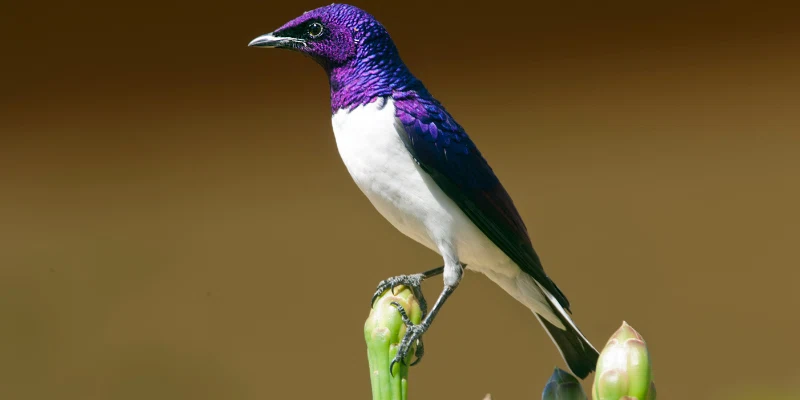
Described as a small starling with remarkable sexual dimorphism, both males and females share a dark bill and a striking lemon-yellow eye.
The males are truly stunning, displaying a color palette that shifts from plum purple to bluish purple, influenced by the sunlight. The only exception to this vibrant display is their white belly.
On the other hand, females and immature birds have white bellies adorned with brown stripes and darker brown upperparts.
Measurement of Violet-Breasted Starling (Cinnyricinclus leucogaster):
- Length: Approximately 20 to 23 cm (about 8 to 9 inches)
- Weight: Around 55 to 75 grams
Habitat:
In Sub-Saharan Africa, the white-bellied sunbird (Cinnyricinclus leucogaster) is a relatively common bird. These starlings prefer the company of small flocks and can be found in open woodlands, riverine forests, and wooded parklands.
Diet:
Their diet mainly consists of fruit and berries, and interestingly, they play a vital role in mistletoe dispersal. Additionally, they also consume insects, particularly winged termites and ants.
3. Purple Finch:
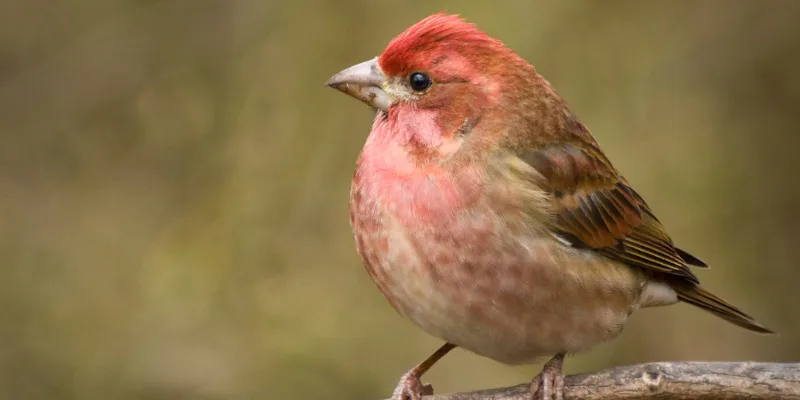
Male birds of this species boast a vibrant raspberry-red coloration on their heads and chests, distinguishing them from the house finch. Unlike the latter, they lack distinctive stripes on their sides. Additionally, the males tend to exhibit more vivid colors, especially on their backs and wings.
The females and immature males display a contrasting head pattern with a pale forehead and a darker cheek.
Measurement of Purple Finch (Haemorhous purpureus):
- Length: Approximately 12 to 15 cm (4.7 to 5.9 inches)
- Wingspan: Around 20 to 25 cm (7.9 to 9.8 inches)
- Weight: Typically between 18 and 32 grams
Habitat:
It is a familiar resident in the northern and eastern regions of the United States, as well as along the Pacific Coast.
This delightful finch thrives in a variety of habitats, including a mix of open and semi-open areas, even venturing into suburban environments. However, it shows a preference for breeding in forested areas.
Diet:
Regarding diet, the purple finch primarily relies on seeds, particularly during the winter months. In the summer, its menu expands to include small fruits, berries, and some insects. This adaptable feeding behavior contributes to its ability to survive and thrive in diverse ecosystems.
4. Varied Bunting:

The males of this bird species boast a spectacular array of tones in their plumage. They exhibit a crimson throat and stomach, a light blue forehead, a purple jaw, and striking red arches behind the eyes.
In contrast, the females are characterized by a warm brown color with minimal markings. They are different from other female buntings by their wings and a more uniformly colored belly.
Another distinguishing feature is the curved upper part of their beak. This distinct coloration in males and females contributes to their visual appeal and aids in identifying the gender differences within the species.
Measurement of Varied Bunting (Passerina versicolor):
- Length: Approximately 12 to 14 cm (about 4.7 to 5.5 inches)
- Wingspan: Typically around 22 to 24 cm (approximately 8.7 to 9.4 inches)
Habitat:
These buntings are residents of the Southwestern United States and Mexico. They are short-distance migrants, undertaking a seasonal movement to Southern Mexico during the winter.
Their preferred habitats include areas with dense cover in arid regions, such as canyons, thorn forests, and desert washes.
Diet:
Feeds on a diverse diet that includes seeds, insects, and berries.
5. Purple Gallinule:

With a conical beak, short tail, small body, and remarkably long legs and fingers, this rail is comparable in size to a chicken.
The distinctive features of the Purple Gallinule (Porphyrio martinicus) include a purple head and neck, greenish wings and back, a red bill with a yellow tip, an azure blue face shield, and light yellow legs and feet.
In their juvenile stage, these birds exhibit much subtler tones, with a notably duller-colored bill, legs, and thighs. Their plumage is primarily brown above and khaki below.
Measurement of Purple Gallinule:
- Length: Approximately 26 to 37 cm (10 to 14.5 inches)
- Wingspan: Typically around 50 to 61 cm (20 to 24 inches)
Habitat:
This species is widespread throughout the Southeastern United States, Mexico, Central America, and South America. Abundant in South America, they are year-round residents in the region.
Their primary habitats include freshwater marshes, although they can also be found on lakes, ponds, reservoirs, and rice fields.
Diet:
Feeds on a varied diet, including aquatic plants, seeds, insects, small fish, and invertebrates.
6. Purple Martin:

The Purple Martin has a long, slightly forked tail and pointed wings, making it the largest swallow species in the United States.
Adult males showcase an iridescent purplish-blue plumage that is particularly noticeable up close, with the rest of their body mainly black.
Females, characterized by a gray hue, feature some markings on the underparts. In contrast, immature individuals have a white abdomen.
Measurement of Purple Martin (Progne subis):
- Length: Approximately 20 to 23 cm (about 8 to 9 inches)
Habitat:
These long-distance migrants breed in the Eastern United States and Canada before embarking on their winter migration to South America.
During their breeding season, you can find them in open fields, wet meadows, parks, and towns, where they establish their nests and raise their young.
Diet:
They primarily feed on flying insects, which they catch during aerial foraging. Their agile flight and manoeuvrability contribute to their insect-catching abilities.
7. Costa’s Hummingbird:

Costa’s hummingbirds, characterized by their small and plump stature with short tails, possess a charming feature: their throat patch resembling a mustache.
Adult males exhibit olive green and gray plumage, adorned with striking purple iridescent crowns and throats.
In contrast, females display more subdued colors, featuring greens and whites in their plumage.
Measurement of Costa’s Hummingbird (Calypte costae):
- Length: Approximately 3 to 3.5 inches (7.5 to 9 cm).
- Weight: Typically around 2 to 5 grams.
Habitat:
These delightful hummingbirds are primarily found in the far Southwestern United States and Mexico along the coast. They inhabit diverse ecosystems such as desert scrub, coastal scrub, and deciduous forests.
Diet:
Costa’s Hummingbirds primarily feed on nectar from flowers. They have specialized long bills and extendable, tube-like tongues for reaching deep into blossoms.
8. Purple Honey Creeper:

The male boasts an indigo-blue plumage adorned with a distinctively narrow black mask, black throat, and wings. Its long, gracefully curved bill and yellow legs further enhance its striking appearance.
In contrast, the female exhibits a predominantly green plumage. Her face is adorned with a subtle beige hue, and a touch of blue mustache adds a touch of elegance.
Together, these features contribute to the unique and charming characteristics of this widely dispersed avian species.
Measurement of Purple Honey Creeper (Cyanerpes caeruleus):
- Length: Approximately 10 to 12 cm (4 to 4.7 inches)
- Weight: Around 9 to 12 grams
Habitat:
This species resides in the northern part of South America, primarily occupying lowland forest canopies. Additionally, they can be spotted on citrus and cocoa plantations, showcasing their adaptability to diverse environments within their range.
Diet:
They primarily feed on nectar from flowers, contributing to pollination. Additionally, their diet includes small insects and fruits.
9. Japanese Paradise-Flycatcher:
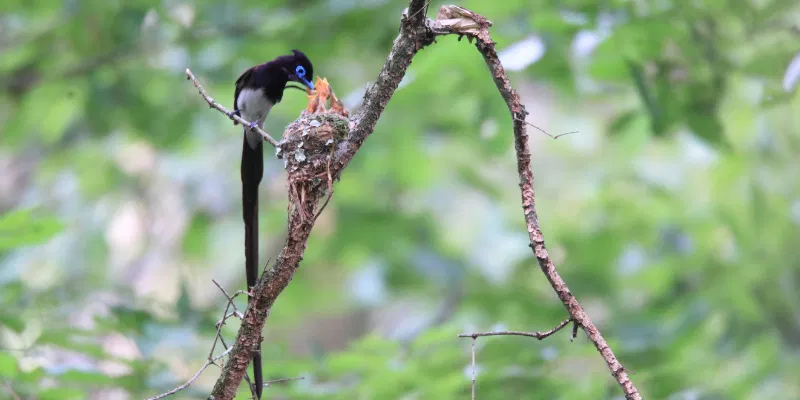
The breeding male boasts a striking appearance, featuring a short crest, neon blue eyelets, and long black streamers on the tail. Their upper plumage is a rich purple-black, contrasting with a pristine white underside.
In contrast, females and non-breeding males exhibit dark gray heads and necks, paler eyes, shorter combs, and brown wings and tails without the distinctive streamers seen in their breeding counterparts.
This marked sexual dimorphism adds to the visual diversity of this remarkable bird species.
Measurement of Japanese Paradise-Flycatcher (Terpsiphone atrocaudata):
- Length: 21 to 25 cm (8.3 to 9.8 inches)
Habitat:
Japanese Paradise-Flycatchers inhabit various forested environments, including deciduous and mixed forests. They are often found in wooded areas with a dense canopy. Their range includes parts of Asia, such as Japan, China, Korea, and parts of Russia.
Diet:
Their primary diet consists of insects, skillfully caught on the wing. They demonstrate adept fly-catching abilities, often perching in the canopy and swiftly darting out to capture flying insects.
10. Purple-Crowned Fairywren:
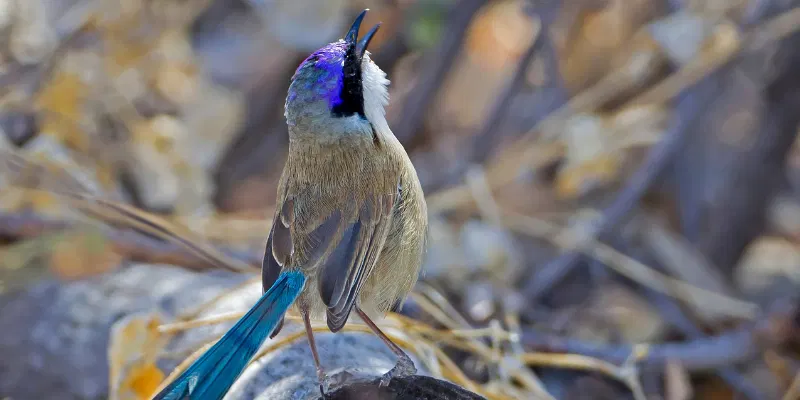
This petite bird is characterized by its distinctive long blue tail. The breeding male showcases a light purple crown adorned with a line of black eyes and a collar. The female, on the other hand, is characterized by conspicuous dark, rusty spots on her cheeks.
In the non-reproductive male, striking black spots grace the cheeks, adding to the bird’s unique features.
Measurement of Purple-Crowned Fairywren (Malurus coronatus):
- Length: 11 to 13 cm (4.3 to 5.1 inches)
Habitat:
Belonging to the Maluridae family, all members of which are native to Australia, the purple-crowned fairywren thrives in the wet tropics of Australia.
They are found in a variety of habitats, including savannas, woodlands, and scrublands with sufficient vegetation for cover.
Diet:
The Purple-crowned Fairywren primarily feeds on a diet of small insects and invertebrates. Their foraging behavior involves searching for prey in the vegetation, including grasses, shrubs, and low branches.
11. Violet Sabrewing:
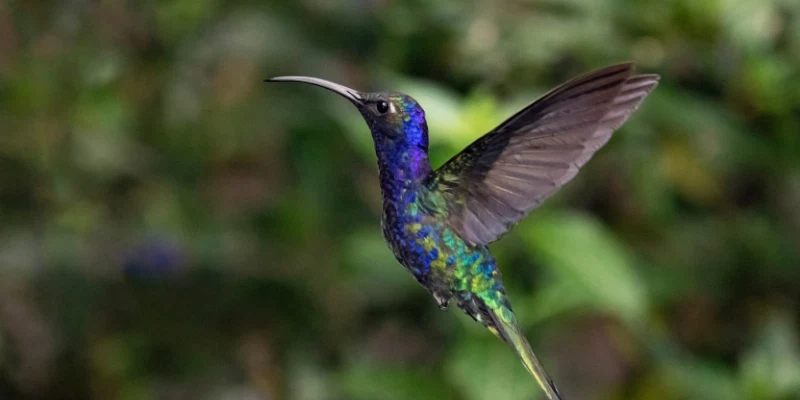
Male individuals showcase a mesmerizing mix of glossy, iridescent blue, purple, green, and black plumage, with metallic violet napes adding to their striking appearance. In contrast, females exhibit bronze and metallic green colors.
Measurement of Violet Sabrewing (Campylopterus hemileucurus):
- Length: Approximately 13 to 15 cm (5 to 6 inches)
Habitat:
These hummingbirds have permanent residence in Southern Mexico and Central America. They prefer habitats such as humid evergreen forests, banana plantations, and gardens.
Diet:
They mostly drink nectar from flowers using their special bills. Sometimes, they also eat small insects and spiders.
12. Purplish Jay:

The purplish jay belongs to the Corvidae family, a diverse bird family that includes nutcrackers, crows, ravens, jays, magpies, and several others. As passerine birds, they hold the distinction of being the largest among their avian counterparts.
The description indicates a large jay characterized by a deep purple-blue hue with a darker head.
Measurement of Purplish Jay (Cyanocorax cyanomelas):
- Length: Approximately 32 to 35 cm (about 12.5 to 13.8 inches)
Habitat:
These jays are native to northern Argentina, Bolivia, southern Brazil, and Paraguay. They thrive in various forest habitats, including subtropical or tropical dry forests and lowland forests.
Diet:
Their diet encompasses a range of food sources, including insects, eggs, reptiles, and fruits.
13. Violet-Crowned Woodnymph:
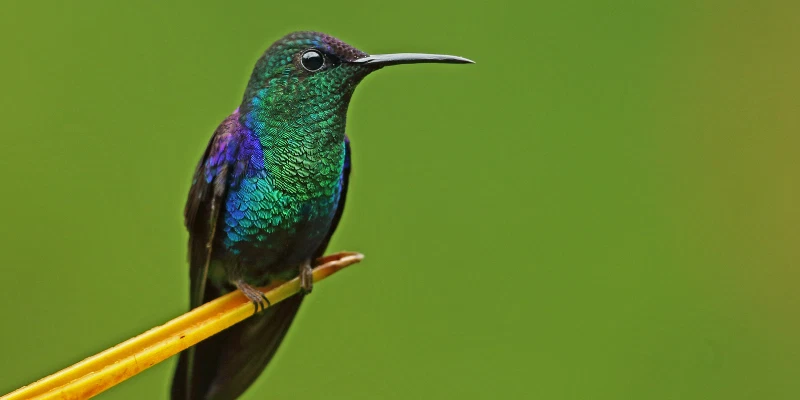
The violet-crowned woodnymph, a long hummingbird characterized by its slender body and extended bill, exhibits vibrant and metallic plumage in males, featuring shades of violet, bronze, and green.
The shimmering throats of males resemble sequins. In contrast, females display more subdued colors, with gray and bluish-green tones and less iridescence.
Measurement of Violet-Crowned Woodnymph (Thalurania colombica):
- Length: Approximately 9 to 11 cm (about 3.5 to 4.3 inches)
Habitat:
These hummingbirds inhabit the northern tip of South America, ranging from Belize to Peru. They prefer living in the interior and edges of humid forests, although they can also be found in cacao plantations and gardens. Classified as emerald hummingbirds, they belong to the Trochilidae family.
Diet:
They feed primarily on nectar from flowers using their specialized long bill. Also consumes small insects and spiders.
Conclusion:
In conclusion, the world of birds offers a diverse array of colors, and purple is undoubtedly one of the most captivating hues found in avian species. From the vibrantly colored Purple Grenadier and Violet-Backed Starling to the gracefully adorned Purple Honey Creeper and Japanese Paradise-Flycatcher, these stunning purple birds add a touch of enchantment to the natural world.
It’s fascinating to note that the purple color in bird feathers results from structural features rather than pigments, leading to a unique interplay of shades influenced by lighting conditions. The rarity of purple among bird species makes encountering these feathered wonders a truly special and fortunate experience for birdwatchers.
This comprehensive guide has provided insights into 13 remarkable purple birds, offering details on their appearance, habitats, and diets. Whether you’re a seasoned bird enthusiast or a casual observer, exploring the world of purple birds adds a delightful dimension to the fascinating realm of birdwatching. So, keep your eyes peeled and your binoculars ready for a chance encounter with these extraordinary avian wonders, and let the beauty of nature unfold before you in shades of purple.
What species of bird is known for its purple color?
One notable example is the Purple Martin (Progne subis), a bird native to North America. The male Purple Martin is known for its iridescent purple feathers, particularly during the breeding season.
Which bird is known for its prominent purple feathers?
The Purple Gallinule (Porphyrio martinicus) is a notable example. This bird, found in the wetlands of the Americas, displays vibrant purple, blue, and green hues in its plumage.
Is there a specific parrot species known for its purple plumage?
Yes, the “Violet-necked Lory” (Eos squamata) is a parrot species recognized for its striking purple plumage.
What kind of bird has a purple head?
One example is the “Purple-crowned Fairy” (Heliothryx barroti), a hummingbird species found in Central and South America. The male Purple-crowned Fairy has a distinctively vibrant purple crown on its head.
: What is an example of a rare bird with purple plumage?
One example of a rare bird with purple plumage is the “Ward’s Trogon” (Harpactes wardi). This elusive bird, found in Southeast Asia, including parts of Myanmar and Thailand, features a stunning combination of purple, green, and red feathers.
Please Write Your Comments